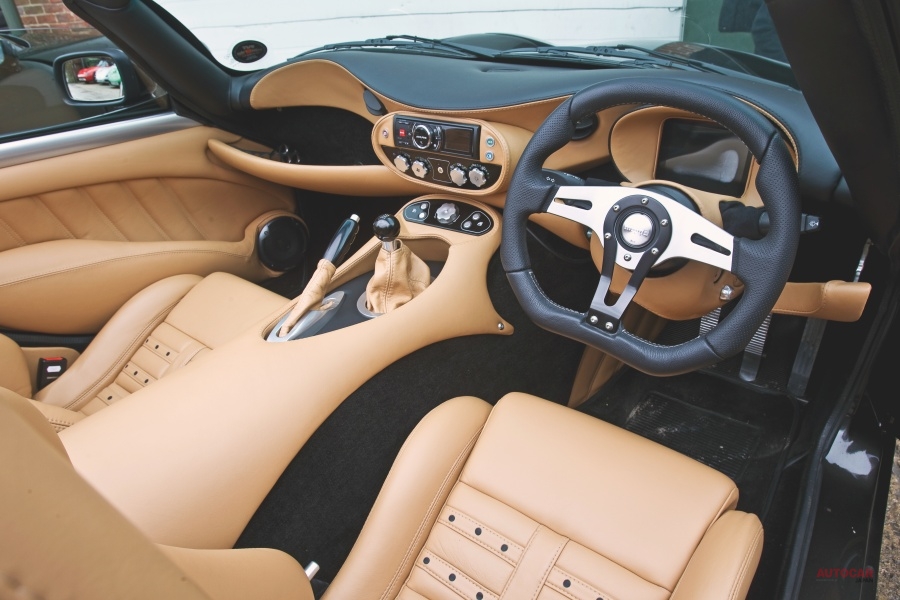Low battery
Battery level is below 20%. Connect charger soon.
TVR Tuscan Interior: The Wildest Car Cabin Design You’ll Ever See
The TVR Tuscan, a name that still ignites passions among car enthusiasts, is legendary for its raw performance and, perhaps even more famously, its unapologetically audacious interior. While the exterior of the Tuscan was sleek and aggressive, the inside was a sensory overload, a thrilling blend of futuristic design and unapologetic individualism. Forget the predictable, the Tuscan’s cabin was a statement – a testament to the fact that automotive design could be as much about art as it was about function. This article delves deep into the heart of the Tuscan, exploring the defining features and the lasting impact of its truly unique interior.
A Symphony of Curves and Colors: The Tuscan’s Design Philosophy
TVR, under the guidance of Peter Wheeler, embraced a design ethos that prioritized the driver’s experience above all else. This translated into an interior that was far from subtle. The Tuscan’s cabin was a riot of curves, flowing lines, and vibrant colors, creating an environment that felt both exhilarating and slightly intimidating. It wasn’t just about aesthetics; every element was carefully considered to create a driver-focused experience.
Key design elements that defined the Tuscan interior include:
- Ergonomic Driver’s Cockpit: The driver’s seat was the focal point, meticulously sculpted to provide excellent support and a low-slung driving position, immersing the driver in the experience.
- Curved Dashboard: The dashboard, a sweeping expanse of curves and angles, was a hallmark of the Tuscan. It wrapped around the driver, placing all controls within easy reach.
- Bold Color Palettes: TVR wasn’t afraid to experiment with color. Interiors often featured two-tone schemes, with contrasting leather, suede, and even aluminum accents.
- Unconventional Switchgear: The Tuscan’s switchgear was anything but ordinary. Often featuring toggle switches and unconventional layouts, it added to the car’s unique character.
- Minimalist Approach to Technology: While some models included features like air conditioning, the focus remained on the driving experience. Technology took a backseat to the raw connection between driver and machine.
Materials and Craftsmanship: The Tuscan’s Luxurious Touch
Despite its unconventional design, the Tuscan’s interior wasn’t lacking in quality. TVR used high-quality materials, including:
- Fine Leather: The seats, dashboard, and door panels were often upholstered in luxurious leather, available in a wide range of colors.
- Alcantara/Suede: Alcantara or suede accents added a touch of sportiness and enhanced the tactile experience.
- Aluminum Accents: Aluminum trim pieces provided a modern and sporty contrast to the leather and suede.
- Hand-Built Construction: Each Tuscan’s interior was meticulously crafted by hand, reflecting a level of attention to detail that was rare in mass-produced cars.
The Driver’s Experience: Immersed in the Thrill
The driving experience in a TVR Tuscan was unlike anything else. The interior played a crucial role in amplifying the car’s raw power and performance. The low driving position, the enveloping cockpit, and the tactile feel of the controls combined to create a truly immersive experience. The car felt like an extension of the driver, fostering a deep connection between man and machine.
The Legacy of the Tuscan Interior: A Lasting Influence
The TVR Tuscan’s interior may have been divisive, but it undeniably left a lasting mark on automotive design. It challenged conventional thinking and demonstrated that a car’s cabin could be a work of art. Its influence can be seen in the increasing willingness of manufacturers to embrace bold designs and driver-focused layouts. The Tuscan’s interior remains a benchmark for those who value individuality, performance, and the thrill of driving.
Frequently Asked Questions (FAQs)
1. What made the TVR Tuscan interior so unique compared to other sports cars of its time?
The Tuscan’s interior stood out due to its bold design, unconventional switchgear, and driver-focused layout. It prioritized aesthetics and the driving experience over conventional practicality, creating a unique and immersive environment.
2. What materials were commonly used in the Tuscan’s interior?
TVR utilized high-quality materials such as fine leather, Alcantara or suede, and aluminum accents throughout the Tuscan’s interior.
3. How did the Tuscan’s interior contribute to the overall driving experience?
The low driving position, enveloping cockpit, and tactile controls created a deep connection between the driver and the car, amplifying the thrill of driving and enhancing the sense of control and immersion.
4. Was the TVR Tuscan interior practical?
Practicality was not the primary focus of the Tuscan’s interior design. While some features like air conditioning were available, the emphasis was on the driver’s experience and a unique aesthetic.
Conclusion
The TVR Tuscan’s interior was more than just a collection of components; it was a statement. It was a testament to a time when automotive design dared to be different, when passion and performance took precedence over the mundane. The Tuscan’s cabin remains a symbol of automotive audacity, an unforgettable experience for those lucky enough to have sat behind the wheel. It’s a reminder that cars can be more than just transportation; they can be works of art, capable of igniting the senses and thrilling the soul.




